The lack of connectivity between Malta and Gozo is turning the smaller island into an old people’s home, Gozo Business Chamber President Michael Grech told The Malta Independent on Sunday.
The tunnel is his hope of turning this situation around and for Gozo to thrive. “Our role, as the Gozo Business Chamber, is to provide as much information as possible as there are a lot of misconceptions about the idea of a tunnel. The general feeling is that people are in favour. More Gozitan families have children who have moved to Malta and we all want our children to move back. The lack of connectivity has also affected the social aspect. Talking to parish priests, they say they have no young people for whom to organise activities during the week. It’s having a heavy impact.
“We need to regenerate the island, and this is a major problem. The character of an island is based on its people.”
Mr Grech was being interviewed about the possibility of a tunnel link between the two islands. It was the Gozo Business Chamber that came up with the idea for a study on a possible tunnel link between the two islands earlier this year, later bringing Transport Malta on board. The original idea for a possible tunnel dates back to 2011.
Asked whether the connection would see a further exodus from Gozo, he said that Maltese would also establish more business in Gozo. “The lack of connectivity has always been a problematic point when trying to attract more business to the island”.
Questioned whether young people would want to stay in a village in Gozo, Mr Grech replied: “Yes, why not? They would be close to their families”. He mentioned another issue where the elderly would move to Malta to be closer to their children. “They are being deprived of being near their family. We want to stay close to family members, to see our grandchildren”.

No need for more buildings in Gozo
Gozo and Malta are two very different islands, with Malta having more hustle and bustle. On this point, Mr Grech stressed that there would be no need for the construction of more buildings. “We have a large stock of unused buildings that can be put on the market. Any other projects would need to be properly assessed. If it’s a five-star hotel project, then I’m in favour of its construction, but if a project involves blocks of apartments, I’m not in favour. We want to keep the villages separate and not see a concrete landscape. The amount of unused buildings in Gozo, ratio-wise, is probably higher than in Malta”.
Turning to the expansion of Gozo General Hospital, improved connectivity would allow people in the North of Malta to go there, thus relieving pressure on Mater Dei Hospital, said Mr Grech. “We also have a new court house being built, that will include five halls. A permanent Judge will be based there, so we might see cases from Malta being heard in Gozo which would help alleviate some of the problems that exist. We also have an ITS school in Gozo, so some students come here. If we are careful of how we organise everything, then we will not spoil the island.
“You could say that there will be more cars on the roads, yes, but don’t forget that at the moment we have peak times, such as summer and Christmas. If we improve connectivity, we might reduce this seasonal aspect and see more of a spread throughout the year. There are some people who don’t like using the ferry if the weather is a bit unsettled and there wouldn’t be that problem with a tunnel. Then there’s also the fact that the ferries disembark 160 cars all at once, causing congestion on the roads, whereas a tunnel would see the traffic more evenly spread.”
The Chamber and Transport Malta covered the expenses for the study together, said Mr Grech, but he was unwilling to reveal the cost.
The study, he said, considered the impact of a tunnel from various angles, including the environmental point of view. “The ferries cause environmental damage, but in a tunnel emissions can be captured”.

Tunnel versus bridge
Apart from costing less than a bridge, Mr Grech said, a tunnel has a longer lifespan than a bridge, and also lower maintenance costs. He also made the point that there would never be a 100 per cent guarantee of being able to use a bridge. “In certain strong wind conditions, it would not be possible to use a bridge.”
Turning to the subject of environmental impact, Mr Grech said that no environmental assessments had been carried out as yet but “we evaluated the cost of emissions coming out of ferries, etc. Geological studies still need to be conducted”.
Geologist Peter Gatt has recently questioned the idea of a tunnel, mentioning a number of geological faults that lie between the two islands. On this issue, Mr Grech said: “This is not something out of this world, something that cannot be overcome. You’d probably find faults here and there in many tunnels around the world”.
“The safest place to be during an earthquake is in a tunnel. We were told this by Norwegian expert who pointed out that tunnels have been constructed in Japan, which experiences intense seismic activity. “So if it’s been done in Japan… Malta hasn’t seen a severe earthquake for centuries.”
Representatives from the Gozo Business Chamber and Transport Malta, together with Dr Gordon Cordina, recently travelled to Norway to meet experts on tunnel construction.

Dr Cordina’s role is to look at different connectivity scenarios between the two islands.
One of the experts they met was Dr Eivind Grov, the same Norwegian expert used by the PN back in 2011 and described by Mr Grech as “the best”.
Asked why he felt the need to carry out the study all over again, he said he felt that the government needed to be pushed to seriously evaluate the tunnel concept. “We wanted Transport Malta to see first-hand how other people construct such tunnels. They came with us to Norway, saw for themselves and were convinced that it is something that can be done.”
He referred to Dr Grov – who is commissioned by governments around the world for his opinion – as a ‘world expert’ on the subject. “He also put us in touch with other experts, including a tunnel psychologist, who advised on tunnel lighting, the benefits of constructing a curved tunnel rather than a straight one so that drivers could focus better on the road, etc.”

Transport Malta CEO James Piscopo is the Chamber’s main contact on this project, said Mr Grech. Asked whether Transport Malta had some reluctance on the idea of a tunnel in the first place, he said they did not. “However, they had a different idea of what could be done. One of the tunnels we saw in Norway passed underneath the city of Trondheim. There were two tunnels intersecting underground with a large roundabout, and that is how they alleviated the traffic problem there.
“We were briefed by the person responsible for that project. They had been in constant communication with the residents, and when they needed to blast underground, they would ask the residents for the most favoured time for such work. Five minutes before blasting, they would send an SMS to the residents in the area to inform them. These were all things Transport Malta took note of.”
Asked whether EU funds would be applied for the project’s construction, he said it would be up to government. “You can have a government project, an EU-financed project, a public-private-partnership or a private project, but it’s up to the government to choose the best option.”
Transport Malta and the Gozo business Chamber will soon call a press briefing to reveal the details of the study to the public. Mr Grech said that they were conservative with the costs of such a project.
Discussing maintenance costs, he said that an underground tunnel would be low maintenance. “Keep in mind that a bridge over salt water, which is corrosive, would have high costs. The main costs for a tunnel would be the electricity needed for the water pumps and lighting, and the cost of pump maintenance.”

Chamber recommending a three-lane tunnel
Mr Grech proposes that a tunnel should consist of three lanes, using the tidal system whereby at certain times two lanes would be directed towards Gozo and at other times two lanes towards Malta. “Obviously it would be up to the experts to decide”.
He also mentioned the need to improve the fibre-optic connectivity between the two islands, saying that a study is being commissioned.
On the subject of tourism spikes in Gozo, and whether he believes Gozo has the infrastructure to deal with the influx, he mentioned the need for a “rethink” on the current infrastructure. One project needed, he said, is a ring-road around Victoria, “because at certain times we already see heavy traffic there. There are problems, of course, and a holistic project for the infrastructure of Gozo is needed, so that once the tunnel is ready we will have the infrastructure in place.”
As for the Gozitan identity, and his view on whether this would change through the construction of a tunnel, he expressed his hope that this will be retained. “I don’t think it will affect our mentality and dialect. Obviously things will change slowly with people coming in, but if you take the Scots and the English, I don’t think their culture has changed. In Wales they promote their own language and that kind of culture is still strong. I think we have enough entities in Gozo for our culture to be kept. We have folklore groups, clubs etc. I don’t think we would lose our identity”.

‘Gozo Channel will not close down’
Mr Grech said he did not think the Gozo ferry would close down if a tunnel was built, but its role would be reduced. “It will be downsized, with smaller boats and a smaller workforce, but it would still have a vital role. Tourists love using the ferry, and schoolchildren on outings see the ferry as adventurous. We believe around 20 per cent of total business would come from the ferry service.”
He explained that the Chamber has been in talks with the Gozo Channel Company about this and said that over the past two years, not a single person has been hired by the company. “There is a natural downsizing going on at the moment – a natural wastage of employees. A high percentage of its workforce is over 55 years old”.
As for toll costs, he would like to see something comparable with today’s ferry prices, but this was something the company or government would have to decide.
Asked whether he had met with locals before launching the tunnel study, Mr Grech said: “We’ve always been in close contact with the business community and we are pretty sure a high percentage of them are in favour”. He said people tell him to keep insisting on greater connectivity. “As far as the man in the street is concerned, there are different reactions but mostly positive. There are discussions as to whether they want a bridge or a tunnel.”
Mr Grech said that both the PN and the PL are in favour of greater connectivity and are likewise both convinced that a tunnel would be the least costly and the most feasible. “The Opposition was always in favour of a tunnel, and in fact there has been a bit of bickering over the past few weeks, with arguments regarding the possible waste of two years by the government. However, that’s political and we don’t get into that!”
As for the site of a tunnel, he said no route had been selected as yet and “it would be up to the experts who conduct the geological studies to make that decision.
“There were around four options being considered back in 2012, with the best being from Ic-Cumnija in Mellieha to Nadur. But it’s not up to us to decide.”
If the project goes ahead, said Mr Grech, the most likely starting date would be 2017 and the tunnel would most likely be built at 100 metres below sea level. As for the length of time it would take to build the tunnel he was unable to say, as it would depend on what is found beneath the sea bed and whether construction work begins from both sides simultaneously.